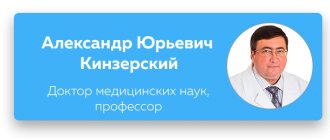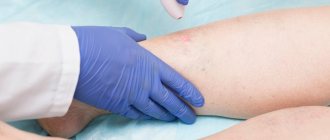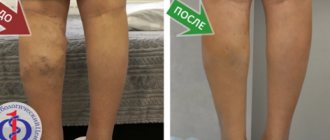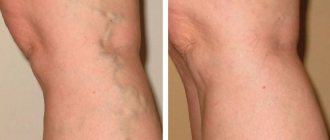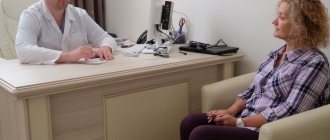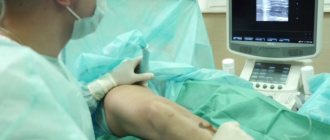Radiofrequency obliteration (ablation) of veins (RFO, RFA) is an intravascular technique for the treatment of varicose veins of the lower extremities, which consists of the impact of high-frequency currents (radiofrequency radiation) on the inner surface of the vein, resulting in the closure of the lumen of the vessel (obliteration) and its subsequent complete resorption (ablation). Radiofrequency vein obliteration is a modern, minimally invasive and one of the safest methods of treating varicose veins.
To perform minimally invasive obliteration of the veins of the lower extremities, the VNUS Medical Technologies radiofrequency coagulation system, consisting of a radiofrequency generator and electrodes, is used.
Briefly about the treatment method
Chronic venous insufficiency in varicose veins develops due to incompetence of the venous valves and reverse blood flow through the saphenous veins (reflux).
Modern technologies for treating varicose veins involve eliminating this reflux, which leads to recovery. Endovenous radiofrequency ablation (EVRF) is one of the effective and painless methods to eliminate this reflux. Endovenous radiofrequency obliteration works by heating the tissue of the venous wall by treating it with microwaves. The effect of exposure to microwaves is to heat tissue to the temperature of protein coagulation. The varicose vein is destroyed by this temperature and becomes obliterated (overgrown). Thanks to this, the reverse discharge of blood through the dilated veins stops, and the venous outflow is normalized.
The advantage of radiofrequency obliteration is the absolute painlessness of the postoperative period compared to other methods of treating varicose veins.
Contraindications to the RFA method:
Despite the safety and other undoubted advantages of the radiofrequency ablation method, this treatment method has a certain range of contraindications. You should not resort to this treatment method in the following cases:
- acute thrombophlebitis
- excessively tortuous or narrow veins
- atherosclerosis on the legs
- overweight
- pregnancy and lactation period.
Before RFA, the phlebologist collects all the necessary data to study the patency of the veins - a duplex scan of the veins is performed. According to indications, you may need to take a general blood test, perform a coagulogram and an ECG.
Advantages of treatment at the ISC
To treat varicose veins, our clinic uses advanced RFO technology from the Belgian company F Care System. This technology involves direct heating of the affected vein with a radiofrequency probe. The latter has a small diameter, comparable to laser fiber for EVLT, and therefore can be carried out into tortuous veins of any diameter, including tributaries and perforators. The EVRF technique from F Care System allows for effective treatment of varicose veins, spider veins and spider veins.
Conservative treatment of varicose veins
Doctors at the Yusupov Hospital, in addition to radiofrequency obliteration of varicose veins of the lower extremities, provide drug therapy for varicose veins. It is aimed at eliminating the symptoms of the disease, preventing complications and improving the quality of life. Complex treatment includes correction of hemodynamic disorders, improvement of microcirculation, and elimination of cosmetic defects.
For varicose veins, phlebologists recommend that patients use medical knitwear and elastic bandages. Dosed compression can reduce the manifestations of varicose veins, slow down the progression of the disease, and improve the quality of life. Doctors at the Yusupov Hospital individually select elastic knitwear of various compression classes for each patient, depending on the severity of venous insufficiency. Compression products help prevent varicose veins.
Phlebologists at the Yusupov Hospital prescribe pharmacological drugs registered in the Russian Federation to patients suffering from varicose veins. They are highly effective and have a minimal range of side effects. The goal of pharmacotherapy for varicose veins is:
- Increased tone of venous vessels;
- Improving lymphatic outflow and microcirculation;
- Relief of inflammatory complications;
- Optimization of physical and chemical characteristics of blood;
- Prevention of thrombotic complications.
Doctors carry out complex drug therapy for varicose veins with the following pharmacological drugs:
- Phlebotonics;
- Peripheral dilators;
- Antiplatelet agents;
- Enzymes;
- Preparations based on prostaglandin E;
- Non-steroidal anti-inflammatory drugs;
- Metabolic drugs.
Ointments and gels based on heparin, phlebotonics, nonsteroidal anti-inflammatory drugs, and corticosteroids are used locally. After radiofrequency ablation of the veins of the lower extremities, patients do not need to use medications.
Preparing for treatment
After examining a phlebologist and determining the indications for treatment of varicose veins using the RFO method, it is necessary to carry out a number of tests:
- General blood analysis
- General urine analysis
- Blood tests for RW, HIV, hepatitis
- Coagulogram
Before the intervention, the phlebologist uses an ultrasound scanner to mark varicose veins and determine the necessary treatment plan. Pathological discharges, perforating veins and large varicose tributaries are necessarily noted. Based on the venous anatomy, the point for installing the intradusser to enter the varicose vein is determined.
It is advisable for the patient not to take food or water 4 hours before surgery, so as not to provoke vomiting during local anesthesia. Clothes should be light and easy to take off.
If RFA - then in “ABIA”:
- Experienced phlebologists and phlebologist surgeons proficient in laser and radiofrequency treatment methods
- Reliable diagnosis already at the initial appointment
- Own laboratory - all necessary studies in the shortest possible time with results by email
- COVIDIEN - precise and reliable Swiss equipment for RFA procedures
- Disposable individual catheters will ensure the safety of the procedure
- No hospitalization - an hour after RFA you go home
ABIA Clinic is a modern medical center equipped with the best equipment. Highly professional doctors and polite staff work here. Here you can undergo a vein examination and sign up for a radiofrequency obliteration procedure. Get rid of varicose veins without pain and risks - vein ablation at ABIA will once again give you health, ease of movement, beauty and self-confidence!
How the treatment method works
After treating the surgical field and anesthetizing the puncture site, a catheter (intraducer) is installed into the varicose vein under ultrasound control, through which a radiofrequency probe is inserted into the lumen and passed to a place 2 cm below the anastomosis between the saphenous and deep veins. The tip of the probe should not go into the femoral or popliteal vein, so as not to cause thrombosis due to damage during the procedure.
Under ultrasound guidance, local anesthesia is applied around the vein using the tight infiltration method. This technology allows you to separate the lymphatic vessels and nerves surrounding the saphenous vein and avoid their damage when treating the vein.
EVRF using F Care System technology is carried out in a continuous mode with slow removal of the probe from the vein. This technique resembles the procedure for laser ablation of varicose veins with the only difference being the slower removal of the probe compared to the laser light guide.
The procedure should be absolutely painless, but if the patient feels warm, an anesthetic solution must be added.
The probe is removed slowly, over 15 to 20 minutes. After this, the catheter is removed from the vein and a pressure bandage is applied.
Reviews of radiofrequency ablation from Dr. Semenov A.Yu.
Thank you for giving me my legs back.
I lived with varicose veins for 25 years and no longer hoped to see my legs healthy. I accidentally found out about a new treatment on the Internet, read reviews about RFA - radiofrequency ablation of veins, and came. The operation was performed by Semenov Artem Yurievich. A superb operation! She came to it herself and left herself after 3 hours. Further sclerotherapy treatment was carried out by Semenov Artem Yurievich. Wonderful doctor, a true professional. My legs look healthy again and...More Kryuchkova Marina Vladimirovna
Possible complications during treatment
Complications of the procedure are very rare. The frequency of complications does not exceed 0.5% of all cases of radiofrequency obliteration of varicose veins.
- Local sensitivity disturbances along the treated veins, which can occur from trauma to the perivenous nerve trunks, but usually these phenomena quickly pass.
- Superficial skin burns if the volume of local anesthetic is not sufficient to provide a buffer between the skin and the saphenous veins, especially below the knee.
- Superficial thrombophlebitis in the treated vein.
- Deep vein thrombosis due to erroneous initiation of coagulation above the anastomosis.
Recovery after RFO procedure
There is no rehabilitation after radiofrequency obliteration, since there is no traumatic factor. Patients experience no pain and can return to work the next day.
However, after RFO it is worth limiting physical activity and thermal effects on the skin (baths, saunas, hot baths). You must wear compression garments for 2-3 weeks. Daily walking on foot will have a positive effect on the body. It is prohibited to engage in fitness, perform anaerobic exercise, or do gymnastic exercises for 1 month.
Prognosis after treatment method
The immediate and long-term results of treatment are very good. Relief from varicose veins over the course of 10 years was noted by 90% of all patients. Patient satisfaction with the treatment outcome is very good, with 95% of patients telling researchers that they would recommend the procedure to their friends.
Recurrence of varicose veins in the next 3 years after RFO was noted by only 5% of patients, and recanalization was not observed, but a relapse was noted due to the development of pathological discharge along the perforating veins.
In multicenter clinical studies, a higher rate of recurrence of varicose veins was noted after RF surgery compared with laser coagulation, but patient satisfaction with treatment results was approximately the same in both groups.
Radiofrequency vein obliteration
Varicose veins are damage to the blood vessels of the lower extremities, which can reduce not only a person’s performance, but also their quality of life. Various technologies have been developed for its treatment. Among them is radiofrequency obliteration. This method involves influencing the surface of a damaged vessel from the inside through high-frequency currents, which promotes not only narrowing of the lumen, but also its complete removal through resorption (ablation).
I'll wait a little longer Make an appointment
The First Phlebological Center, operating in Moscow, provides a full range of services for the diagnosis of varicose veins and its treatment, including using radiofrequency ablation of veins. Experienced specialists work here. They will select the optimal treatment option for each specific case.
Features of RFO
Radiofrequency obliteration is a minimally invasive operation performed under local anesthesia. RFA is performed using a special device that emits radio frequencies and electrodes. The entire course of the operation is monitored by ultrasound. Using a special syringe, a puncture is made in the GSV, into which an adapter is inserted, and through it - a radiofrequency surgical catheter, at the end of which there is a working zone, which is entrusted with the task of “sealing” the damaged vessel. Sensors built into the catheter monitor the degree of wave action on the vessel wall. Radiofrequency exposure is carried out exclusively on the wall of the vein, without affecting the tissues that are in its surroundings. It only takes a few minutes to work with one subcutaneous vessel.
1 category
From 10 to 20 cm of the length of the coagulated vein
RUB 59,600
2nd category
From 20 to 30 cm of the length of the coagulated vein
66,200 rub.
3 category
More than 30 cm of the length of the coagulated vein, also a short segment (less than 10 cm of the coagulated vein), the presence of tortuosities due to which the placement of 2 or more introducers is necessary
75,000 rub.
4th category
In patients with recurrent varicose veins
78,900 rub.
| Fill out an application on the website, we will contact you as soon as possible and answer all your questions. | Registration online |
Treatment results for our patients
Disease: varicose veins
Treatment method: EVLT + MINIFLEBECTOMY
Combined treatment of varicose veins. Endovasal laser obliteration of the vein on the left leg (EVL) + Miniphlebectomy
Disease: varicose veins
Treatment method: EVLT + MINIFLEBECTOMY
Laser treatment (EVLT) followed by miniphlebectomy of the tributaries of the great saphenous vein on the thigh and shin of the right leg. Miniphlebectomy of varicose veins.
Disease: Telangiectasia
Treatment method: Foam sclerotherapy
To remove the stars, the patient underwent a session of microfoam sclerotherapy (Foam-Form) of the reticular veins under the control of laser transillumination.
Disease: varicose veins
Treatment method: EVLT + MINIFLEBECTOMY
Upon examination of the patient, varicose veins were diagnosed on the right leg. Combined treatment with EVLT + miniphlebectomy was performed.
Indications and contraindications for RFO
Vein ablation is a procedure prescribed for stem-type varicose veins affecting the small or large saphenous vein.
The use of RFA is not allowed in the following cases:
- thrombophlebitis or previously treated thrombosis;
- atherosclerosis of arteries;
- skin diseases in the area where penetration is expected;
- pregnancy or breastfeeding;
- inability to actively move after surgery.
A strong bend, which the large or small saphenous vein may have, can also become a contraindication for the procedure, since it will not be possible to insert a catheter through it.
Advantages of RFA:
- no need for general anesthesia;
- minimum incision sizes;
- this method is a gentle surgery that is not accompanied by pain;
- there is no need for long-term hospitalization;
- quick recovery after the procedure.
- very rare relapses and low risk of complications.
Preparation for RFO and recovery period
Endovenous vein ablation does not require special preparation. It is performed based on the results of a preliminary examination of the patient. A few days before the procedure, it is necessary to stop taking anti-inflammatory drugs, stop using creams, ointments, etc. on the lower limb where the procedure will be performed.
Rehabilitation after radiofrequency ablation of veins is not long. Immediately after the operation, a compression stocking is put on, which he will have to wear for one to two weeks. For several days you will have to give up gymnastics and training, with the exception of walking (about an hour daily), but sitting or standing for a long time is not recommended.
You will only have to give up your usual lifestyle for a few days, but at the same time you will get rid of varicose veins and your legs will be beautiful and healthy again. All that is required of you is to go to the clinic on time.
Observation program after treatment method
Compression is very important after any vein treatment procedure. Compression is effective in reducing postoperative bruising and tenderness, and may also reduce the risk of developing venous thromboembolism in both the treated leg and the untreated leg. Class II (30 to 40 mm Hg gradient) compression stockings are applied to the treated leg, and if the patient desires, it is also applied to the untreated leg. Bed rest and heavy lifting are prohibited, and normal activity is encouraged. The patient is returned 3-7 days after surgery, at which time duplex ultrasonography should demonstrate a closed great saphenous vein and no evidence of thrombus in the femoral, popliteal, or deep veins of the leg. At 6 weeks, examination should reveal clinical resolution of the stem varices, and evaluation should also demonstrate a completely closed vessel and no reflux remaining. If any residual open segments are noticed, sclerotherapy is performed under ultrasound guidance.
How is the modern vein RFA procedure performed?
1. Firstly, it should be noted that all manipulations of this medical procedure are carried out under the strict control of ultrasound machines. An RF catheter is inserted under the skin into the affected vein through a microscopic puncture.
A radiofrequency catheter is inserted into the affected vein
Then, when the doctor is completely convinced of the correct positioning of the catheter along the varicose vein, a so-called “water cushion” is created - an anesthetic is injected around the vein in order to anesthetize the procedure and well protect nearby tissues from thermal effects.
2. After these manipulations, the radio frequency generator is started, which transmits waves to the catheter. The device has the ability to treat up to seven centimeters of the affected vein in one turn, after which the catheter is advanced further along the vein.
Radiofrequency catheter seals the diseased vein
Thus, gradually, the entire vessel affected by varicose veins is treated.
3. After the procedure is completed, the place where the special needle was inserted is covered with a bandage. A special medical compression garment is put on the treated limb. Postoperative hospitalization is not required, so the patient goes home independently after the procedure.
The RFA procedure ends and a compression stocking is put on.
If we compare this procedure with European laser treatment, it is worth saying that the RF generator is independently capable of selecting operating modes in certain veins, in contrast to the laser method, where the result of the procedure directly depends on the qualifications and skills of the doctor. That is, a good effect from laser obliteration is directly dependent on the professionalism of the specialist and does not allow the slightest mistakes. However, radiofrequency ablation of veins involves a fair number of nuances, which can also affect the effectiveness of the procedure. Therefore, it is better to entrust its implementation to an experienced, and ideally, the best specialist.

